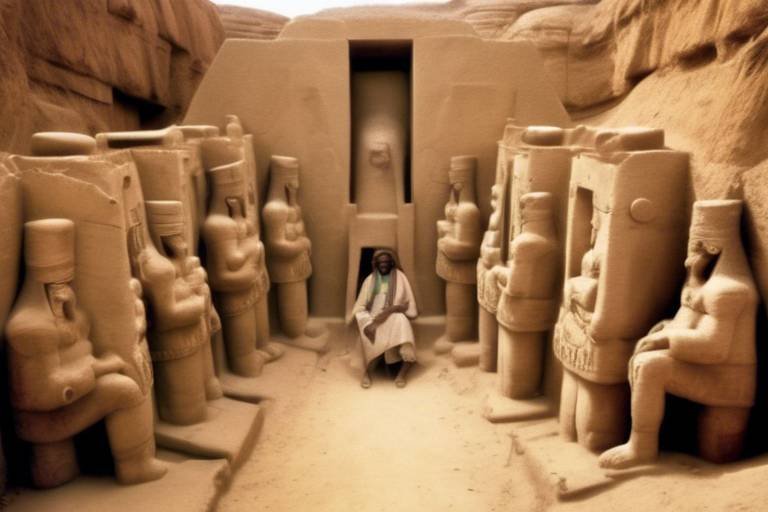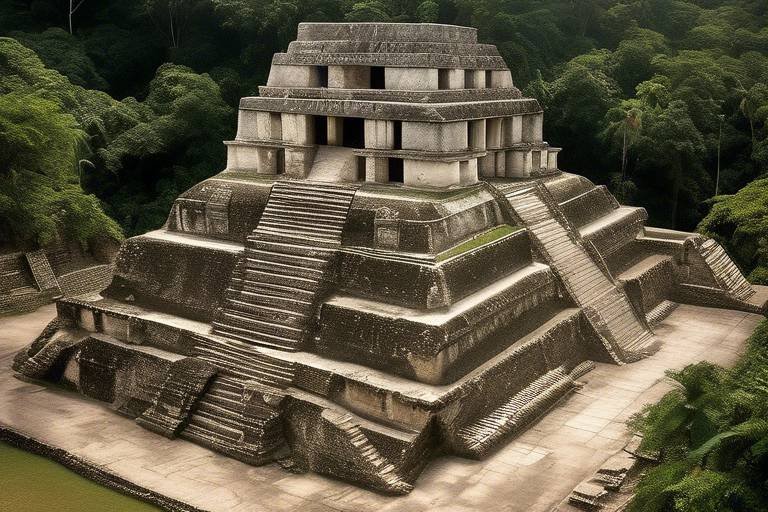The Forgotten Achievements of the Kushite Kingdom
The Kushite Kingdom, nestled in the heart of Nubia, stands as a testament to the ingenuity and prowess of an ancient civilization often overshadowed by its more renowned counterparts. Despite the passage of time, the achievements of the Kushites continue to captivate historians and archaeologists, offering a glimpse into a world of remarkable accomplishments that have left an indelible mark on history.

Architecture and Monuments
The Kushite Kingdom, located in Nubia, had remarkable accomplishments often overshadowed by other ancient civilizations. Exploring their achievements sheds light on an intriguing and influential society that played a significant role in shaping history.
The Kushites were skilled builders, creating impressive structures and monuments that reflected their advanced architectural knowledge and cultural sophistication. One of the most renowned examples of their architectural prowess is the construction of the pyramids at Meroe. These pyramids, though smaller in size compared to the Egyptian pyramids, are equally impressive in design and construction. The Kushites incorporated unique elements into their architecture, such as distinctive pyramid shapes and elaborate decorations, showcasing their artistic flair and engineering capabilities.
Furthermore, the Kingdom of Kush was home to magnificent temples dedicated to their deities. The Temple of Amun at Jebel Barkal stands as a testament to their religious devotion and architectural mastery. The intricate carvings and hieroglyphics adorning the temple walls depict scenes from religious ceremonies and historical events, providing valuable insights into Kushite beliefs and rituals.
In addition to monumental structures, the Kushites also excelled in urban planning, creating well-organized cities with efficient infrastructure. The city of Meroe, for instance, featured well-designed streets, residential areas, and public buildings, showcasing the kingdom's progressive approach to urban development.
Overall, the architecture and monuments of the Kushite Kingdom not only demonstrate their technical skills but also highlight their cultural sophistication and artistic creativity, leaving a lasting legacy that continues to captivate historians and archaeologists.
Q: What were the major architectural achievements of the Kushite Kingdom?
A: The Kushites are renowned for their construction of pyramids, temples, and well-planned cities, showcasing their advanced architectural knowledge and cultural sophistication.
Q: How did religion influence Kushite architecture?
A: Religion played a central role in Kushite society, influencing the design and decoration of temples and monuments, reflecting their spiritual beliefs and cultural practices.
Q: What is the significance of the Temple of Amun at Jebel Barkal?
A: The Temple of Amun is a remarkable example of Kushite religious architecture, featuring intricate carvings and hieroglyphics that provide insights into their religious beliefs and rituals.
Q: How did urban planning contribute to the development of Kushite cities?
A: The Kushites excelled in urban planning, creating well-organized cities with efficient infrastructure, such as the city of Meroe, which showcased their progressive approach to city development.

Trade and Economy
The trade and economy of the Kushite Kingdom were fundamental to its prosperity and influence in the ancient world. Situated at the crossroads of major trade routes, including the Nile River, the Red Sea, and the Sahara Desert, Kush served as a vital hub for commercial activities that brought wealth and resources to the kingdom.
One of the key factors driving the Kushite economy was its control over valuable resources such as gold, ivory, ebony, and incense, which were highly sought after by neighboring civilizations and distant lands. Through strategic trade agreements and diplomatic relations, the Kushites established lucrative networks that allowed them to export these goods and import luxury items, enhancing their economic stability and cultural prestige.
The kingdom's geographical positioning played a crucial role in facilitating trade, as it provided access to both maritime and overland routes, enabling the Kushites to engage in extensive commerce with regions as far as the Mediterranean and the Arabian Peninsula. This strategic advantage not only boosted their economy but also fostered cultural exchanges that enriched Kushite society with diverse influences.
Moreover, the Kushites were adept at utilizing their natural resources for economic development, employing advanced agricultural techniques, such as irrigation systems and crop diversification, to ensure food security and surplus production. This agricultural surplus not only sustained the population but also fueled trade activities by enabling the kingdom to export agricultural products to neighboring regions in exchange for goods and services.
In addition to physical goods, the Kushite economy also thrived on intellectual and artistic exchanges, with scholars, craftsmen, and artists contributing to the kingdom's cultural wealth through innovations in science, literature, and the arts. This intellectual commerce not only boosted the kingdom's reputation as a center of learning but also attracted foreign scholars and traders, further enriching the economic landscape of Kush.
Overall, the trade and economy of the Kushite Kingdom were integral to its success and influence in the ancient world, showcasing a sophisticated network of commercial activities, resource management, and cultural interactions that sustained the kingdom's prosperity and legacy for centuries to come.

Religious Practices
Religion held a profound significance in Kushite society, shaping their beliefs, rituals, and daily practices. The Kushites worshipped a diverse pantheon of deities, each representing different aspects of nature, life, and the afterlife. One of the most prominent gods was Amun, the king of the gods, associated with fertility, creation, and the sun. The Kushites believed in an afterlife and practiced elaborate funerary rituals to ensure a smooth transition for the deceased into the next realm.
Temples played a central role in Kushite religious practices, serving as sacred spaces where priests conducted ceremonies, offerings, and prayers to honor the gods. The most famous temple dedicated to Amun was the Jebel Barkal temple in Napata, a grand structure adorned with intricate carvings and hieroglyphics that reflected the spiritual devotion of the Kushite people. These temples were not only places of worship but also centers of cultural and artistic expression, showcasing the Kushites' reverence for divine beings.
The Kushites practiced animal sacrifice as part of their religious rituals, offering livestock such as cattle, sheep, and goats to appease the gods and seek their favor. These sacrifices were seen as a way to maintain harmony between the earthly realm and the divine realm, ensuring the well-being of the kingdom and its people. Additionally, priests and priestesses played vital roles in interpreting dreams, performing divination, and communicating with the gods on behalf of the community.
Symbolism and iconography were integral to Kushite religious art, with intricate designs and motifs depicting divine beings, sacred animals, and mythological scenes. The Kushites believed in the power of symbols to convey spiritual truths and invoke the presence of the gods in their daily lives. Artifacts such as amulets, jewelry, and statues were imbued with symbolic meaning, serving as talismans of protection and sources of spiritual guidance for the people.

Art and Culture
The Kushite Kingdom, located in Nubia, had remarkable accomplishments often overshadowed by other ancient civilizations. Exploring their achievements sheds light on an intriguing and influential society that played a significant role in shaping history.
The art and culture of the Kushite Kingdom were a vibrant tapestry woven with influences from various neighboring civilizations, creating a unique and distinctive identity. The Kushites excelled in artistic expressions, ranging from intricate pottery to monumental sculptures that adorned their cities and temples.
One of the most notable aspects of Kushite art was its fusion of Egyptian and indigenous Nubian styles, resulting in a harmonious blend that reflected their diverse cultural heritage. The kingdom's artists were skilled in depicting scenes from daily life, religious ceremonies, and mythological narratives with great detail and precision.
Moreover, Kushite culture was characterized by a deep appreciation for music, dance, and storytelling. The kingdom's inhabitants celebrated festivals with colorful performances, where music filled the air and dancers moved in graceful harmony, captivating audiences with their skill and artistry.
Archaeological findings have revealed the intricate jewelry, pottery, and textiles crafted by the skilled artisans of the Kushite Kingdom, showcasing their mastery of craftsmanship and artistic expression. These artifacts not only served utilitarian purposes but also reflected the aesthetic sensibilities and cultural values of the society.
Furthermore, the Kushites' reverence for the divine was evident in their art, with temples and tombs adorned with elaborate reliefs and paintings depicting scenes from religious rituals and mythological beliefs. The kingdom's religious practices influenced every aspect of artistic creation, infusing their art and culture with spiritual significance and symbolism.
In conclusion, the art and culture of the Kushite Kingdom stand as a testament to the creativity, ingenuity, and cultural richness of this ancient civilization. Through their artistic achievements, the Kushites left a lasting legacy that continues to inspire and fascinate scholars and art enthusiasts alike.

Military Power
The Kushite Kingdom, located in Nubia, had remarkable accomplishments often overshadowed by other ancient civilizations. Exploring their achievements sheds light on an intriguing and influential society that played a significant role in shaping history.
The military prowess of the Kushites was legendary, earning them a formidable reputation on the battlefield. Their strategic alliances and skilled tactics allowed them to defend their kingdom and expand their influence across the region. The Kushite warriors were trained to perfection, combining discipline with courage to face any adversary that dared to challenge their might.
One of the key strengths of the Kushite military was their adaptability. They were quick to learn from their enemies and incorporate new tactics and technologies into their own strategies. This flexibility gave them an edge in warfare, allowing them to outmaneuver larger armies and emerge victorious in battles that seemed unwinnable.
Moreover, the Kushites were adept at leveraging their geographical positioning to their advantage. Their knowledge of the terrain, coupled with their mastery of guerrilla warfare tactics, made them a formidable force to reckon with. They could strike swiftly and retreat just as fast, leaving their enemies bewildered and defeated.
Additionally, the Kushites were skilled in the art of diplomacy, forging alliances with neighboring kingdoms to strengthen their military power. These alliances not only provided them with additional resources and troops but also allowed them to expand their influence and control over key trade routes in the region.
In essence, the military power of the Kushite Kingdom was a force to be reckoned with, combining strategic brilliance, tactical prowess, and unwavering determination. Their legacy as fierce warriors continues to be studied and admired, showcasing a chapter of history where a small kingdom rose to prominence through the strength of its military might.
Q: What were the key factors that contributed to the military success of the Kushites?
A: The military success of the Kushites can be attributed to their skilled warriors, strategic alliances, adaptability in warfare, and mastery of guerrilla tactics.
Q: How did the geographical positioning of the Kushite Kingdom influence their military strategies?
A: The Kushites utilized their knowledge of the terrain and mastery of guerrilla warfare tactics to outmaneuver their enemies and strike with precision, leveraging their geographical positioning to their advantage.
Q: What role did diplomacy play in enhancing the military power of the Kushite Kingdom?
A: Diplomacy allowed the Kushites to forge alliances with neighboring kingdoms, strengthening their military capabilities through shared resources, troops, and strategic advantages.

Political Structure
The Kushite Kingdom, located in Nubia, had remarkable accomplishments often overshadowed by other ancient civilizations. Exploring their achievements sheds light on an intriguing and influential society that played a significant role in shaping history.
The political structure of the Kushite Kingdom was characterized by a complex system that supported a centralized government. Rulers wielded power through a combination of diplomacy, military might, and cultural influence, creating a robust framework for governance.

Technological Advancements
The Kushite Kingdom, located in Nubia, had remarkable accomplishments often overshadowed by other ancient civilizations. Exploring their achievements sheds light on an intriguing and influential society that played a significant role in shaping history.
The technological advancements of the Kushite Kingdom were pivotal in their prosperity and societal development. One of their notable achievements was in agriculture, where they implemented innovative irrigation systems to support their crops. By harnessing the power of the Nile River, the Kushites were able to cultivate fertile lands and ensure a stable food supply for their people.
In addition to agriculture, the Kushites excelled in craftsmanship, particularly in metalworking and pottery. Their skilled artisans produced intricate jewelry, tools, and pottery that showcased their mastery of these crafts. These technological advancements not only enhanced the quality of life for the Kushite people but also contributed to their economy through trade and commerce.
Furthermore, the Kushites' expertise in architectural engineering is evident in the construction of their monumental structures. They utilized advanced techniques in stone masonry and engineering to build temples, pyramids, and palaces that stood as testaments to their architectural ingenuity. These structures not only served as religious and administrative centers but also demonstrated the Kushites' advanced knowledge in construction and design.
1. What was the significance of the Kushite Kingdom in ancient history?
The Kushite Kingdom played a crucial role in ancient history, influencing trade, culture, and politics in the region.
2. How did the Kushites contribute to technological advancements?
The Kushites made significant contributions to agriculture, craftsmanship, and architecture through their innovative practices and skilled artisans.
3. Why are the achievements of the Kushite Kingdom often overlooked?
Despite their remarkable accomplishments, the achievements of the Kushite Kingdom are often overshadowed by other ancient civilizations, leading to their historical significance being underestimated.

Legacy and Influence
The Kushite Kingdom, located in Nubia, had remarkable accomplishments often overshadowed by other ancient civilizations. Exploring their achievements sheds light on an intriguing and influential society that played a significant role in shaping history.
The legacy of the Kushite Kingdom is deeply intertwined with its enduring influence on subsequent civilizations. Despite the lack of widespread recognition in modern times, the impact of Kushite culture and achievements can be seen in various aspects of history.
One of the most notable contributions of the Kushite Kingdom is its architectural prowess, evidenced by the construction of impressive monuments and structures that still stand today. These architectural marvels serve as a testament to the advanced skills and ingenuity of the Kushite builders, inspiring awe and admiration in all who behold them.
Furthermore, the Kushites' strategic positioning along key trade routes facilitated economic prosperity and cultural exchange, leaving a lasting imprint on the development of trade networks in the ancient world. Their thriving economy and access to valuable resources enabled the kingdom to flourish and establish itself as a significant player in regional commerce.
Religiously, the Kushites held unique beliefs and practices that permeated every aspect of their society. Their spiritual traditions not only shaped their artistic expressions but also provided a moral and ethical framework for governance and social interactions. The influence of Kushite religious practices can be traced in the symbolism and iconography of their art and architecture.
Militarily, the Kushites were renowned for their formidable prowess on the battlefield, employing advanced tactics and forming strategic alliances to protect their kingdom and expand their influence. Their military achievements not only secured their borders but also projected power and authority beyond their territories.
Politically, the Kushite Kingdom's centralized government structure and diplomatic acumen allowed them to navigate the complex web of regional politics with finesse. Rulers wielded power through a delicate balance of military might, cultural influence, and strategic alliances, ensuring the stability and longevity of their reign.
Moreover, the Kushites made significant technological advancements in various fields, from agriculture to craftsmanship, enhancing their overall prosperity and quality of life. Their innovations in irrigation systems and agricultural practices contributed to the sustainability of their society and laid the groundwork for future developments.
In conclusion, while the achievements of the Kushite Kingdom may have been overshadowed by other ancient civilizations, their legacy endures through the influence they exerted on subsequent societies. The study and appreciation of Kushite culture and accomplishments continue to shed light on a fascinating chapter of history that deserves recognition and admiration.
Frequently Asked Questions
- What were the main architectural achievements of the Kushite Kingdom?
The Kushite Kingdom was known for its impressive structures and monuments, such as the pyramids at Meroe and the Nubian temples. These constructions showcased the advanced architectural skills and cultural sophistication of the Kushites.
- How did trade contribute to the prosperity of the Kushite Kingdom?
Trade played a vital role in the economy of the Kushite Kingdom, as they were strategically located along major trade routes. This enabled them to exchange valuable resources such as gold, ivory, and incense, contributing to their economic prosperity.
- What was the significance of religion in Kushite society?
Religion was central to Kushite society, influencing various aspects of their culture, art, and daily life. The Kushites had unique religious beliefs and practices that shaped their worldview and artistic expressions.
- How did the Kushites demonstrate their military prowess?
The Kushites were renowned for their military strength and strategic alliances, allowing them to defend their kingdom and expand their influence in the region. Their skilled military tactics and powerful armies were key to their success in warfare.
- What technological advancements did the Kushite society achieve?
The Kushites made significant advancements in various fields, including agriculture, irrigation systems, and craftsmanship. These technological innovations contributed to their overall prosperity and societal development.
- What is the lasting legacy of the Kushite Kingdom?
Despite being overshadowed by other ancient civilizations, the Kushite Kingdom left a lasting legacy that continues to influence later societies. Their cultural achievements and historical significance are still studied and appreciated by scholars and archaeologists today.



















